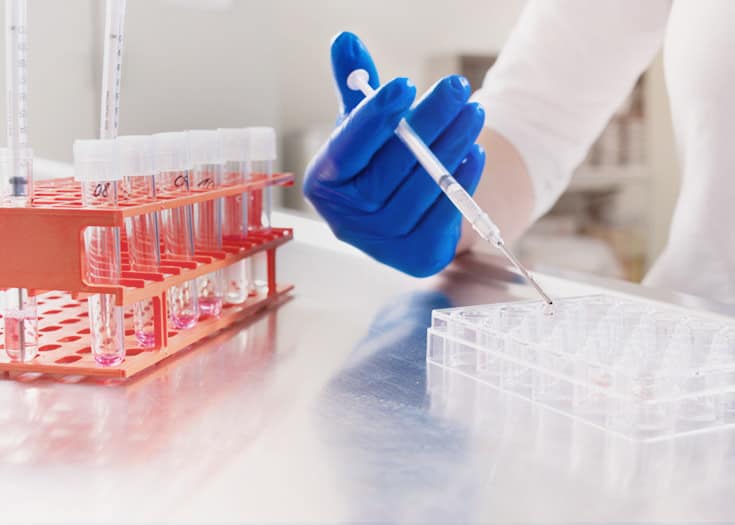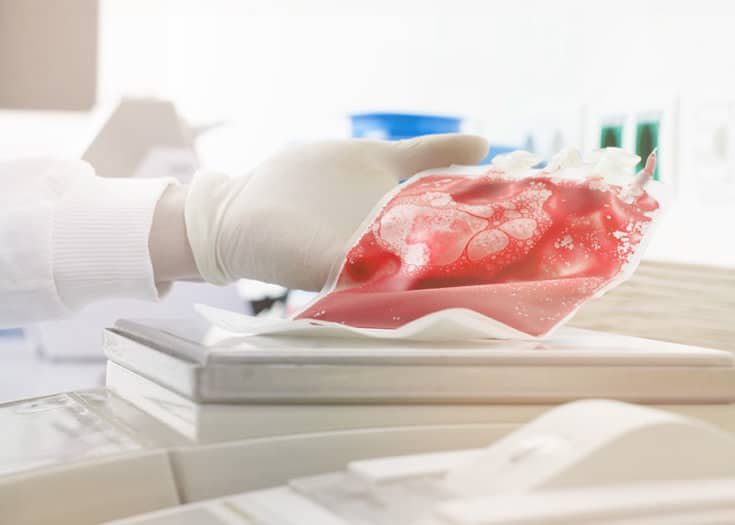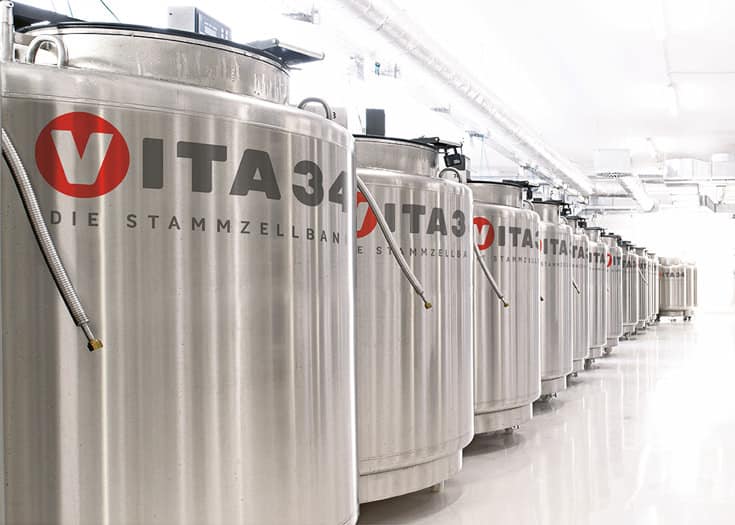Successful stem cell therapies are no science fiction anymore
Stem cells from the umbilical cord are special. They are young, potent, and viable. Numerous clinical studies are being conducted worldwide researching the suitability of stem cells for the regeneration of damaged tissues after accidents, degenerative diseases like e.g. slipped intervertebral discs, or cancer treatment. Like Vita 34, many health professionals and scientists believe in the potential of stem cells: Umbilical cord blood and tissue that is rich in stem cells will be an important therapeutic option in future medicine.

Stem cell therapies give hope to many patients and are an important therapeutic option.
Vita 34 actively participates in this development. We are involved with our in-house department of research and development and in collaboration with leading universities and research institutions all over Europe in basic and application research. Vita 34-customers benefit from this knowhow: The expanding knowledge in stem cell research makes your child’s stem cell deposits more valuable every day.

Applications of stem cells in modern medicine
Stem cells have been long established in cancer therapy
Stem cells have been applied in the treatment of serious diseases for more than 55 years. They are applied especially to treat cancers, which require high-dose chemotherapy within the scope of medical care. The patient’s own stem cells are extracted from bone marrow or peripheral blood prior to high-dose chemotherapy, stored temporarily and transplanted after the treatment in order to minimize the side effects of the aggressive chemotherapy and to support the regeneration of destroyed cells.

Applications of stem cells in modern medicine
Stem cells have been applied in the treatment of serious diseases for more than 55 years. They are applied especially to treat cancers, which require high-dose chemotherapy within the scope of medical care. The patient’s own stem cells are extracted from bone marrow or peripheral blood prior to high-dose chemotherapy, stored temporarily and transplanted after the treatment in order to minimize the side effects of the aggressive chemotherapy and to support the regeneration of destroyed cells.
Besides cancer, several 100,000 people come down with common diseases like dementia, which belongs to the neurodegenerative diseases, cardiac infarction, stroke, arthritis, or diabetes every year. The lifelong therapy causes enormous costs in the health care system. Stem cell therapy offers great potential for the treatment of such diseases. Experts expect that every seventh person up to the age of 70 will need a therapy based on stem cells in the future to regenerate sick or aged cells and tissues.
Stem cells stored with Vita 34 are actually being applied
To be able to store stem cells does not automatically mean to apply stem cells. The transplantation of stem cells requires enormous knowledge and experience. So far, 51 stem cell deposits stored with Vita 34 have been applied in practice. They were already applied in the treatment of cancers (like leukemia and neuroblastoma), hematopoietic disorders (like aplastic anemia or beta thalassemia), immune defects (like SCID or Wiskott Aldrich syndrome), infantile brain damage, and infantile diabetes type 1.
"Stem cells are called the building blocks of life, because an entire human being develops from the very first stem cell. The potential of stem cells therefore is enormous and already provides for entirely new therapeutic options in the field of individualized, regenerative medicine.”
Dr. Wolfgang Knirsch (CEO)
By the way, as measured by applications in clinical treatment attempts and studies, Vita 34 is the most experienced private stem cell bank in Europe.
The possible applications of stem cells increase
Scientists expect further findings and developments in the field of stem cell therapy in the next years.

Areas of application of stem cells.
Stem cells have already been applied successfully for:
- Hematopoietic disorders
- Acute and chronic leukemia (AML/ALL or CML/CLL)
- Myelodysplastic syndrome
- Lymphomas (Hodgkin lymphoma, non-Hodgkin lymphoma)
- Aplastic anemia
- Sickle cell anemia
- Beta thalassemia
- Immunodeficiency
- SCID
- Whiskott Aldrich syndrome
- Metabolic disorders
- Mucopolysaccharidosis
- Cancer
- Multiple myeloma
- Neuroblastoma
In clinical studies and treatment attempts, stem cell therapies are tested with the following indications:
- Autoimmune diseases
- Diabetes mellitus type 1
- Rheumatoid arthritis
- Lupus
- Crohn’s disease
- Graft-versus-host disease (GvHD)
- Impairments of the brain
- Dementia, in particular Alzheimer’s disease
- Stroke
- Brain injuries due to accidents or cancer
- Infantile brain damage (cerebral paresis)
- Cardiovascular diseases
- Cardiac infarction
- Multiple sclerosis
- Amyotrophic lateral sclerosis
- Autism
- Hearing loss
- HIV
- Cirrhosis of the liver
- Epidermolysis bullosa (“butterfly children”)
Further Topics

Compare products and prices
As a precaution, store either the umbilical cord blood or the umbilical cord tissue after the birth of your child. We offer both at different prices and terms. Also a financing is possible. Optionally, you can also donate the umbilical cord blood.
Hello. Do you need further information?
Our guidebook for parents contains comprehensive information on the subject of cord blood storage. Order the guidebook by mail at no charge and without any obligation.





